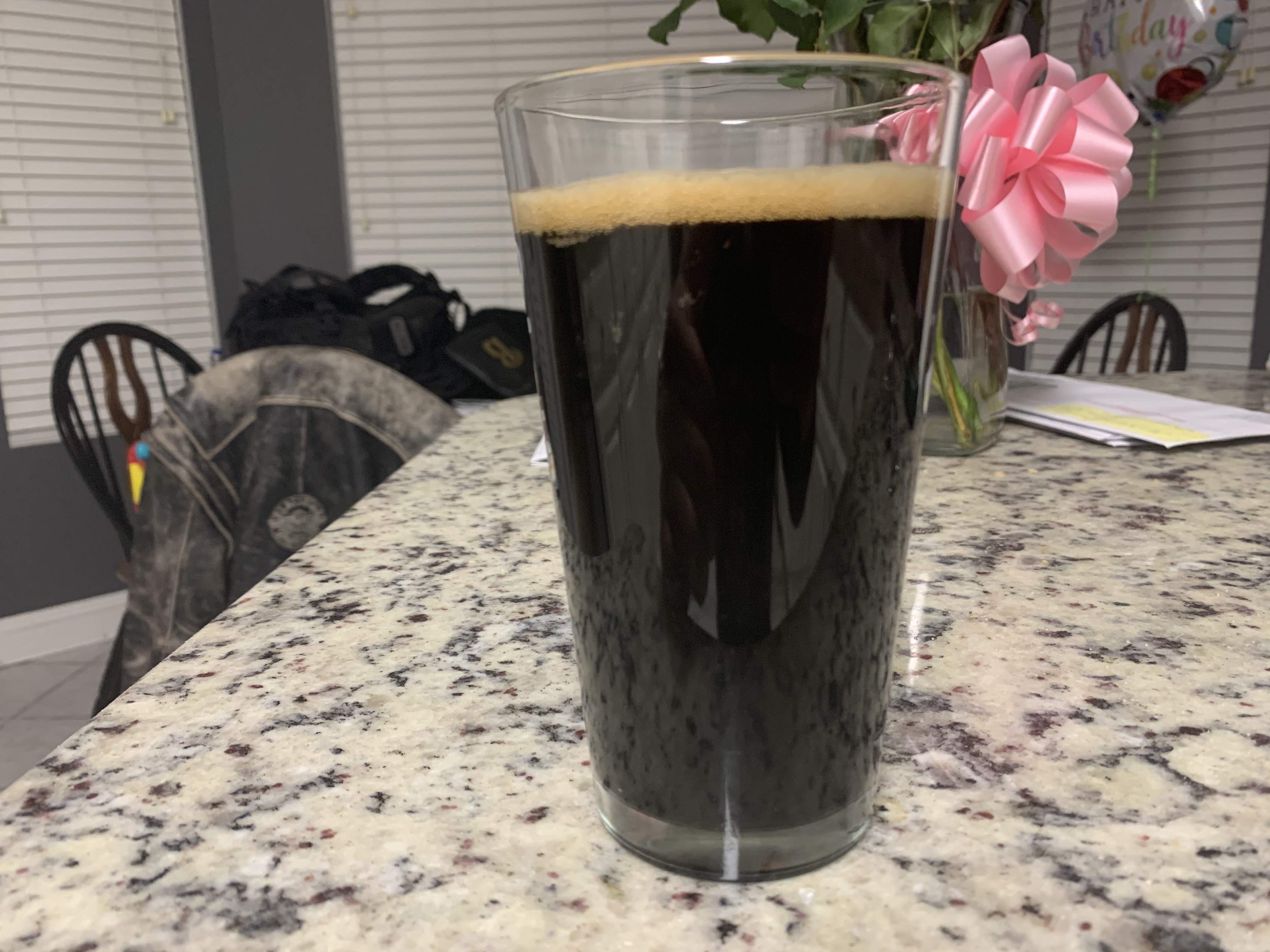So I am new here but have brewed several times before. My previous brews have been under the supervision of my LHBS operator as a “brew on premise”. The lil woman got me equipment to brew at home for Christmas (she’s a keeper).
I brewed this recipe last year and it turned out wonderfully and has aged even better. Under my desire and my shopkeepers guidance we made a small change that I will describe later. This is an extract with specialty grains recipe.
The recipe is as follows for a 5 gal batch;
Initial boil was almost 6 gal starting water and going into fermenter I was just a hair above 5.
1 lb Cherrywood Smoked Malt
12 oz Carafa 1
8 oz Chocolate Malt
8 oz Flaked Oats
8 oz Malted Oats
4 oz Flaked Barley
4 oz Roasted Barley
8 oz Caramel/Crystal Malt 60L
1 lb Dark DME @ boil
6.6 lb Pale Liquid Extract
.75 oz Magnum @ 60
.25 oz East Kent Goldings @ 15
1 lb Lactose @ 15
1 pk SafAle S-04
This time around we added 2oz cocoa nibs soaked in 2oz bourbon to be added after primary (kreuesen drop).
Fermentation has been in a 7.9 gal Fastferment conical.
After the kreuesen dropped I took the ball off and cleaned the sediment. Sanitized and put the ball back on, dumped the cocoa and bourbon in and let it go.
This was boiled on 1-05-2020
Wort gravity was 1.075 after cooling
Yeast was pitched at about 68 F
Recipe called for the wort to be at 1.072
And estimated final to be at 1.019
First night was little to no activity in airlock
Second and third evenings was steady rapid activity in the airlock
Fourth and so on have slowed to very little in airlock. Maybe every 30 seconds now.
Cocoa nibs and bourbon were added on 01-10-2020. Clear top on liquid (no signs of kreuesen).
Now since I am having such slow airlock activity I figured I would check progress. Plus I’m skipping town for the weekend.
Gravity on 1-14-2020 was 1.030
Gravity on 1-16-2020 was 1.029 ish
When I did this brew without cocoa or bourbon I didn’t know the numbers as it was supervised by someone who knew what they were doing and they told me when to come bottle. That brew came out great and aged even better. But the bottled beer is slightly over carbonated, meaning that the caps have bulged and are holding and when opened you run a good chance of commuting some beer abuse. A pour must be done cautiously or you will end up with massive head.
Beer man says that we probably got some extra fermentation in the bottle causing the minor over carbonation.
So the big question is should I begin to think about bottling this latest batch or should I keep waiting another week?
Sorry for the novel.
ETA: temps have been 68-70 before kreuesen drop and 66 after. Only monitored not controlled.
I brewed this recipe last year and it turned out wonderfully and has aged even better. Under my desire and my shopkeepers guidance we made a small change that I will describe later. This is an extract with specialty grains recipe.
The recipe is as follows for a 5 gal batch;
Initial boil was almost 6 gal starting water and going into fermenter I was just a hair above 5.
1 lb Cherrywood Smoked Malt
12 oz Carafa 1
8 oz Chocolate Malt
8 oz Flaked Oats
8 oz Malted Oats
4 oz Flaked Barley
4 oz Roasted Barley
8 oz Caramel/Crystal Malt 60L
1 lb Dark DME @ boil
6.6 lb Pale Liquid Extract
.75 oz Magnum @ 60
.25 oz East Kent Goldings @ 15
1 lb Lactose @ 15
1 pk SafAle S-04
This time around we added 2oz cocoa nibs soaked in 2oz bourbon to be added after primary (kreuesen drop).
Fermentation has been in a 7.9 gal Fastferment conical.
After the kreuesen dropped I took the ball off and cleaned the sediment. Sanitized and put the ball back on, dumped the cocoa and bourbon in and let it go.
This was boiled on 1-05-2020
Wort gravity was 1.075 after cooling
Yeast was pitched at about 68 F
Recipe called for the wort to be at 1.072
And estimated final to be at 1.019
First night was little to no activity in airlock
Second and third evenings was steady rapid activity in the airlock
Fourth and so on have slowed to very little in airlock. Maybe every 30 seconds now.
Cocoa nibs and bourbon were added on 01-10-2020. Clear top on liquid (no signs of kreuesen).
Now since I am having such slow airlock activity I figured I would check progress. Plus I’m skipping town for the weekend.
Gravity on 1-14-2020 was 1.030
Gravity on 1-16-2020 was 1.029 ish
When I did this brew without cocoa or bourbon I didn’t know the numbers as it was supervised by someone who knew what they were doing and they told me when to come bottle. That brew came out great and aged even better. But the bottled beer is slightly over carbonated, meaning that the caps have bulged and are holding and when opened you run a good chance of commuting some beer abuse. A pour must be done cautiously or you will end up with massive head.
Beer man says that we probably got some extra fermentation in the bottle causing the minor over carbonation.
So the big question is should I begin to think about bottling this latest batch or should I keep waiting another week?
Sorry for the novel.
ETA: temps have been 68-70 before kreuesen drop and 66 after. Only monitored not controlled.
Last edited:




